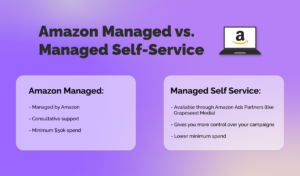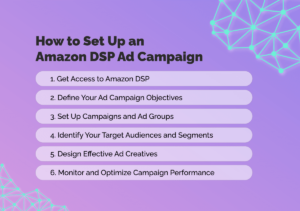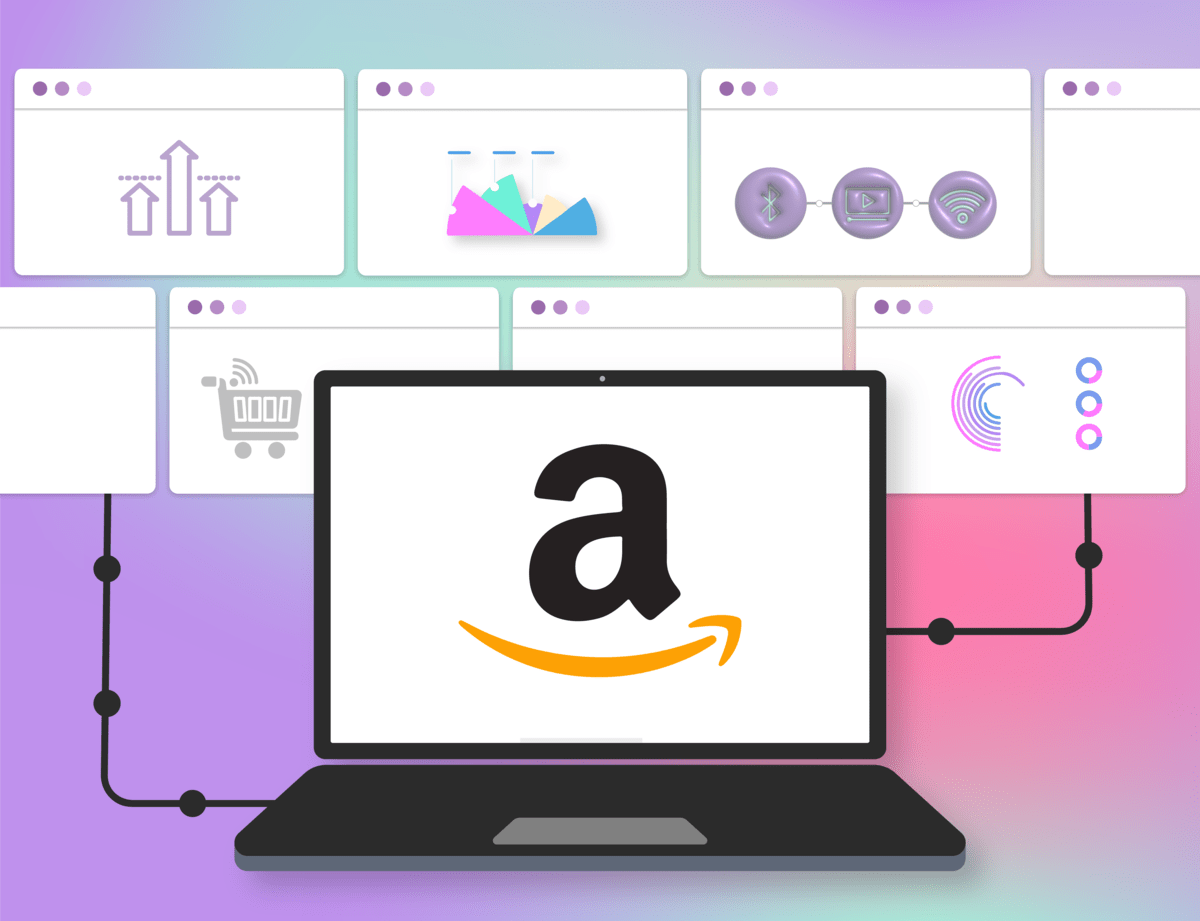Amazon isn’t just an e-commerce store that caters to your every whim — it also offers a range of services for businesses, including Amazon Demand-Side Platform (DSP) for advertisers. Amazon DSP allows advertisers to buy programmatic display, video, and audio ad placements on websites and mobile apps outside of Amazon, as well as all Amazon owned-and-operated websites like IMDB, Good Reads, and Twitch. The scale of Amazon DSP’s reach is unmatched, with estimates suggesting it can reach 98% of all websites and apps.
Using Amazon DSP for ad campaigns can help you reach target audiences, increase brand visibility, and drive conversions. It leverages Amazon’s shopper data to target high-intent shoppers and drive sales on and off Amazon. These audience insights are particularly valuable now that the end is in sight for third-party cookies, as it enables advertisers to take advantage of Amazon’s vast amounts of first-party data.
This article will walk you through a step-by-step process to set up an Amazon DSP ad campaign. But first, let’s take a look at Amazon DSP’s features and how it works.
Amazon DSP’s Features
Amazon DSP differs from other options for Amazon advertising — such as sponsored display ads — in a number of ways, including the following:
- Amazon DSP is a cost-per-mille (CPM) platform rather than a pay-per-click (PPC) platform.
- Unlike Amazon sponsored products, brands that don’t sell products or services on Amazon can reach valuable Amazon audiences and drive traffic to their website or online store.
- Advertisers can bid on specific Amazon user groups (created based on their online shopping behavior), whereas sponsored ads bid on specific keywords and individual ASINs (Amazon Standard Identification Numbers).
- Advertisers can scale Amazon DSP ads to target qualified in-market shoppers across all leading publishers’ sites and mobile apps, as well as Amazon-owned-and-operated sites and apps.
Now let’s go through the six-step process that will help you set up your first Amazon DSP campaign.
Step 1: Get Access to Amazon DSP
There are two ways advertisers can access Amazon DSP: Amazon Managed and Managed Self-Service:
Amazon Managed
Amazon offers a direct managed service option that includes consultative support, making it a good choice for those with limited programmatic advertising experience. However, advertisers must commit to a minimum spend that’s usually in the tens of thousands (prices vary by region but are typically around $50,000) to gain access to this service.
Managed Self-Service
This option is only available to Amazon Agency Partners, and it gives advertisers more control over their campaigns. By working with an Amazon Ads Partner like Grapeseed Media, advertisers can bypass the minimum $50,000 spend requirement to allow for more budget flexibility.

Step 2: Define Your Ad Campaign Objectives
It’s essential to set clear objectives before setting up an Amazon DSP ad campaign because your goals will directly impact the different DSP ad types, inventory options, and targeting tactics you use depending on the results you want to drive.
Some common campaign objectives include driving more sales, increasing brand awareness, or promoting new product launches. On Amazon DSP, some of the most popular goals include the following:
- Awareness: Introducing the brand and its products to new users and reminding existing customers about them.
- Consideration: Presenting a product as a potential solution to a customer need, problem, or pain point.
- Conversion: Distinguishing a brand from competitors and persuading the user to make a purchase.
Step 3: Set Up Orders and Line Items
When you set up your Amazon DSP campaigns, you can also set line items (ad groups) that give you access to different ad inventory types, targeting devices, audience types, and targeting options. As well as thinking about budget and when the order will run, you’ll need to consider the following parameters for robust campaigns:
- Frequency: The number of times the same user can be exposed to any creatives in a line item on a single screen.
- User location: The geographic location of the target customers.
- Supply sources: These are the supply-side-platforms (SSPs) that connect publishers with buyers. By default, a creative is eligible to run on all available exchanges, Amazon-owned sites, and Amazon Publisher Services ad inventory and supply sources.
- Use daypart targeting: Allows advertisers to target users by time of day.
- Location targeting by: Allows for the inclusion and exclusion of users based on their postal code, city, state, or country.
- Third-party pre-bid targeting: Default filters to exclude invalid and irrelevant traffic.
- Viewability: Choose the baseline percentage of inventory that has a chance of being seen (70% is our recommended benchmark). Viewability percentages are not guaranteed but are based on historic performance and machine learning.
- Domain: Target whitelists by restricting ads to only those websites you want to appear on or exclude blacklists by specifying sites you do not want to appear on.
Step 4: Identify Your Target Audiences and Segments
As with any online ad campaign, you don’t want to target all users — only the ones who fit your audience criteria and will therefore be more likely to buy your products or services. This is where audience targeting and segmentation come in — you can create custom audience segments on Amazon DSP to target specific groups and increase the effectiveness of your ads.
The advantage of Amazon DSP is that you can draw from Amazon’s extensive customer data, such as user behavior, purchase history, and search queries to create custom audience segments. However, you’re free to include your own first or second-party data, such as demographic information, online behavior, and offline purchases.
Targeting options available on Amazon DSP include:
- Contextual
- In-market
- Lifestyle
- Audience lookalike
- Remarketing
Step 5: Design Effective Ad Creatives
Compelling e-commerce creatives can capture your target audience’s attention and boost engagement and sales. The ad formats available for your creatives on Amazon DSP are display, video, and audio.
- Display ads include website and mobile ads, mobile app ads, and mobile interstitials.
- Video ads include online video ads and streaming TV ads (formerly known as OTT/CTV ads).
- Audio ads: These are usually ten to 30-second clips of digital audio advertising content streamed across first and third-party platforms and services.
As with any type of online advertising, effective ad creatives for Amazon DSP are ones with memorable, attention-grabbing headlines, high-quality visuals, persuasive ad copy, and clear CTAs. Take the time to perfect your ad creatives before setting them loose on the world.
Once you have your creatives, upload them using the appropriate Amazon DSP ad specs, and the approval process begins. This usually takes 24 hours, but it can sometimes take longer, so make sure you allow plenty of time. Once the creatives are approved, your campaign is ready to go live.
Step 6: Monitor and Optimize Campaign Performance
Although optimization comes once your campaign is set up, it’s an essential part of your Amazon DSP campaign strategy that will help you identify what works well and what doesn’t so you can adjust your campaigns accordingly.
The metrics you use to measure the success of your campaign will vary depending on the goals you set out at the beginning, but they may include:
- Impressions
- Click-through rates
- Conversions
- Product detail page view rate
- Attributed sales
- Units sold
- Purchase rate

Find New Customers and Boost Sales with Amazon DSP
A well-planned and executed Amazon DSP ad campaign can be a gold mine for your business, drawing on Amazon’s vast amounts of first-party data to identify, target, and reach new potential customers.
If you want to get the most out of your Amazon DSP advertising campaign (and bypass the minimum $50,000 spend), we recommend partnering with an Amazon Ads Partner like Grapeseed Media. Our team of programmatic experts has extensive experience setting up and managing successful campaigns and will be happy to do the same for your business.
Looking for more information about Amazon DSP? Get in touch with the team or chat with Grape Bot by clicking the chat button at the bottom right of your screen.






